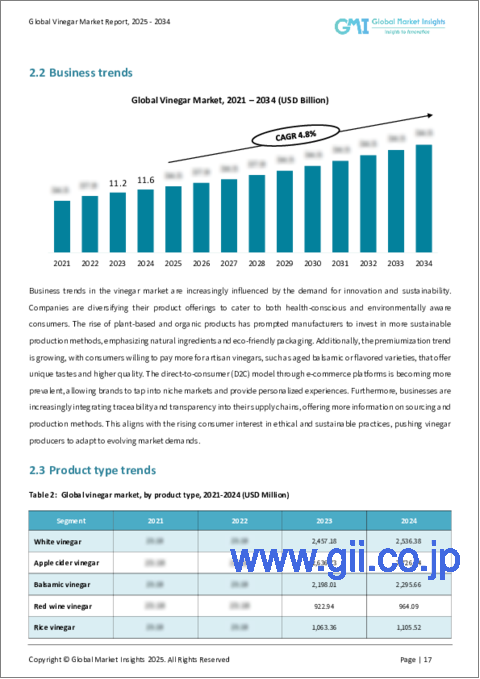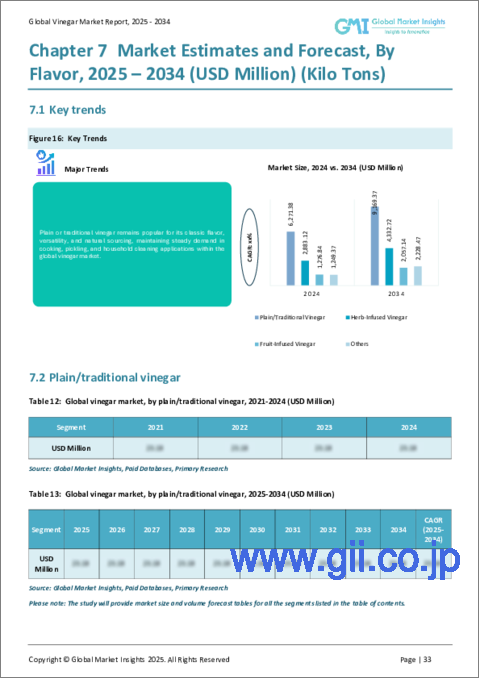|
|
市場調査レポート
商品コード
1628268
食酢の市場機会、成長促進要因、産業動向分析、2025年~2034年予測Vinegar Market Opportunity, Growth Drivers, Industry Trend Analysis, and Forecast 2025 - 2034 |
||||||
カスタマイズ可能
|
|||||||
| 食酢の市場機会、成長促進要因、産業動向分析、2025年~2034年予測 |
|
出版日: 2024年11月25日
発行: Global Market Insights Inc.
ページ情報: 英文 235 Pages
納期: 2~3営業日
|
- 全表示
- 概要
- 目次
世界の食酢市場は2024年に108億米ドルとなり、2025年から2034年にかけてCAGR 4.4%で成長すると予測されています。
この成長は、より健康的で自然な食品オプションに対する消費者需要の増加が原動力となっています。酢酸菌を通してエタノールを発酵させた製品である酢は、食品の下ごしらえ、保存、ソースやマリネの主要成分など、多様な用途があります。
市場は従来の品種にとどまらず、有機酢、風味酢、特殊酢への関心が高まっています。健康志向の消費者は、消化を助けたりダイエットをサポートしたりといった健康効果が期待できるビネガーに惹かれており、市場拡大に寄与しています。さらに、グルメ料理やエスニック料理への需要の高まりが、家庭と外食産業の両方での消費拡大につながった。食酢メーカーは、風味、パッケージング、持続可能な調達における革新で、進化する消費者の嗜好に対応しています。
食酢業界は、健康志向の食生活へのシフトに後押しされ、着実な成長を続けています。消化器系の健康と体重管理を促進する製品を求める消費者の間で、リンゴ酢や有機酢の人気が高まっています。バルサミコ酢や米酢のような香味酢や特殊酢も、人々が多様な料理体験を探求するにつれて需要が急増しています。食酢は食品保存、調味料、サラダドレッシングなど幅広い用途に使用されるため、家庭用と外食用の両部門で安定した需要が確保されています。持続可能性に対する意識の高まりは、環境に配慮した製品を好む消費者の動向と一致し、企業が環境に優しいパッケージを採用するよう促しています。
| 市場範囲 | |
|---|---|
| 開始年 | 2024 |
| 予測年 | 2025-2034 |
| 開始金額 | 108億米ドル |
| 予測金額 | 166億米ドル |
| CAGR | 4.4% |
食酢市場は、白酢、リンゴ酢、バルサミコ酢、米酢、その他など製品タイプ別に区分されます。汎用性が高く手頃な価格のホワイトビネガーが市場を独占し、大きな収益をあげています。白酢の人気は、ドレッシングやマリネなどの食品用途や、洗浄などの非食品用途での幅広い用途に牽引されています。白酢はまた、DIY洗浄液として費用対効果が高く、環境に優しい代替品を求める消費者にも支持されています。
供給源の面では、2024年には合成酢が80%と圧倒的なシェアを占めています。酢酸から製造される合成酢はコスト効率が高く、大規模な食品加工、洗浄、工業用途に最適です。合成酢の手頃な価格と安定性は、家庭用と工業用の両方で急成長の要因となっています。
風味酢、特に果実入りは成長分野です。消費者は、ソース、マリネ、ドレッシングに使用する複雑な風味を提供するフルーツ入りビネガーなど、ユニークで汎用性の高い料理オプションにますます惹かれています。この動向は、職人技を駆使した高級食品に対する需要の高まりと一致しています。
オンライン小売チャネルは、eコマースの利便性と消費者の宅配志向に後押しされ、最も急速に成長している流通手段となっています。オンライン・プラットフォームにより、消費者は、実店舗ではあまり見かけないような特殊品種や有機品種を含む、より幅広い食酢製品にアクセスすることができます。さらに、飲食品産業が最大の用途分野であることに変わりはなく、これは食酢の料理用途における多用途性と、包装食品の天然保存料としての魅力によるものです。
米国の食酢市場は、自然志向で健康志向の製品への需要が大きく、世界的にリードしています。消費者は食酢を食材としてだけでなく、健康食品や洗浄剤としても利用しています。オンライン小売店や専門食品店で食酢を購入できるようになったことも、人気の高まりを後押ししています。
目次
第1章 調査手法と調査範囲
第2章 エグゼクティブサマリー
第3章 業界洞察
- エコシステム分析
- バリューチェーンに影響を与える要因
- 利益率分析
- 破壊
- 将来の展望
- メーカー
- 流通業者
- サプライヤーの状況
- 利益率分析
- 主要ニュース
- 規制状況
- 影響要因
- 促進要因
- 飲食品業界における食酢の需要拡大
- 食酢の健康効果に対する意識の高まり
- 製造技術の進歩
- 業界の潜在的リスク&課題
- 原料価格の変動
- 食酢代替品との競合
- 促進要因
- 成長可能性分析
- ポーター分析
- PESTEL分析
第4章 競合情勢
- イントロダクション
- 企業シェア分析
- 競合のポジショニング・マトリックス
- 戦略展望マトリックス
第5章 市場推計・予測:製品タイプ別、2021年~2034年
- 主要動向
- ホワイト酢
- リンゴ酢
- バルサミコ酢
- 赤ワイン酢
- 米酢
- 寿司酢
- その他
第6章 市場推計・予測:ソース別、2021年~2034年
- 主要動向
- 有機
- 合成
第7章 市場推計・予測:フレーバー別、2021年~2034年
- 主要動向
- プレーン/伝統的な酢
- ハーブ入り酢
- フルーツ入り酢
- その他
第8章 市場推計・予測:流通チャネル別、2021年~2034年
- 主要動向
- B2B
- 卸売・バルクサプライヤー
- 食品メーカー
- 産業用・商業用クリーニングサプライヤー
- B2C
- スーパーマーケットおよびハイパーマーケット
- コンビニエンスストア
- オンライン小売
- その他
第9章 市場推計・予測:用途別、2021年~2034年
- 主要動向
- 飲食品産業
- 家庭用
- 医療・医薬品
- 化粧品・パーソナルケア
- その他
第10章 市場推計・予測:地域別、2021年~2034年
- 主要動向
- 北米
- 米国
- カナダ
- 欧州
- 英国
- ドイツ
- フランス
- イタリア
- スペイン
- ロシア
- アジア太平洋
- 中国
- インド
- 日本
- 韓国
- オーストラリア
- ラテンアメリカ
- ブラジル
- メキシコ
- 中東・アフリカ
- 南アフリカ
- サウジアラビア
- アラブ首長国連邦
第11章 企業プロファイル
- ACETUM
- Aspall Cyder
- Australian Vinegar
- Burg Groep
- Carl Kuhne
- Castelo Alimentos
- Charbonneaux-Brabant
- De Nigris
- Eden Foods
- Fleischmann's Vinegar Company
- Galletti
- Marukan Vinegar
- Mizkan America
- Shanxi Shuita Vinegar
- The Kraft Heinz Company
The Global Vinegar Market was valued at USD 10.8 billion in 2024 and is projected to grow at a CAGR of 4.4% from 2025 to 2034. This growth is driven by increasing consumer demand for healthier and more natural food options. Vinegar, a product made by fermenting ethanol through acetic acid bacteria, has diverse uses, including food preparation, preservation, and as a key ingredient in sauces and marinades.
The market has extended beyond conventional varieties, with growing interest in organic, flavored, and specialty vinegars. Health-conscious consumers are drawn to vinegar for their potential health benefits, such as aiding digestion and supporting weight loss, thus contributing to market expansion. Additionally, the rise in demand for gourmet cooking and ethnic cuisines has led to greater consumption in both households and the food service industry. Vinegar producers are responding to evolving consumer preferences with innovations in flavor, packaging, and sustainable sourcing.
The vinegar industry continues to experience steady growth, fueled by a shift towards wellness-focused diets. The popularity of apple cider vinegar and organic varieties is increasing as consumers seek products that promote digestive health and weight management. Flavored and specialty vinegar, such as balsamic and rice vinegar, are also seeing a surge in demand as people explore diverse culinary experiences. Vinegar's broad use in food preservation, condiments, and salad dressings ensures consistent demand across both household and food service sectors. Rising awareness of sustainability encourages companies to adopt eco-friendly packaging, aligning with consumer trends favoring environmentally conscious products.
| Market Scope | |
|---|---|
| Start Year | 2024 |
| Forecast Year | 2025-2034 |
| Start Value | $10.8 Billion |
| Forecast Value | $16.6 Billion |
| CAGR | 4.4% |
The vinegar market is segmented by product type, including white vinegar, apple cider vinegar, balsamic vinegar, rice vinegar, and others. White vinegar, a versatile and affordable option, dominates the market, generating substantial revenue. Its popularity is driven by its wide range of uses in food applications, such as dressings and marinades, and non-food uses, including cleaning. White vinegar is also favored by consumers seeking cost-effective, eco-friendly alternatives for DIY cleaning solutions.
In terms of sources, synthetic vinegar holds a dominant share of 80% in 2024. It is produced from acetic acid and is cost-effective, making it ideal for large-scale food processing, cleaning, and industrial uses. The affordability and consistency of synthetic vinegar contribute to its rapid growth in both household and industrial applications.
Flavored vinegar, particularly fruit-infused varieties, is a growing segment. Consumers are increasingly drawn to unique and versatile culinary options, such as fruit-infused vinegars, which offer complex flavors for use in sauces, marinades, and dressings. This trend aligns with the rising demand for artisanal and premium food products.
The online retail channel is becoming the fastest-growing distribution method, driven by the convenience of e-commerce and consumer preference for home delivery. Online platforms allow consumers to access a wider range of vinegar products, including specialty and organic varieties, not commonly found in physical stores. Additionally, the food and beverage industry remains the largest application segment, driven by vinegar's versatility in culinary uses and its appeal as a natural preservative in packaged foods.
The U.S. vinegar market leads globally, with significant demand for natural and health-focused products. Consumers are using vinegar not only as a food ingredient but also as a wellness product and cleaning agent. The growing availability of vinegar through online retail and specialty food stores further supports its rising popularity.
Table of Contents
Chapter 1 Methodology & Scope
- 1.1 Market scope & definitions
- 1.2 Base estimates & calculations
- 1.3 Forecast calculations
- 1.4 Data sources
- 1.4.1 Primary
- 1.4.2 Secondary
- 1.4.2.1 Paid sources
- 1.4.2.2 Public sources
Chapter 2 Executive Summary
- 2.1 Industry synopsis, 2021-2034
Chapter 3 Industry Insights
- 3.1 Industry ecosystem analysis
- 3.1.1 Factor affecting the value chain
- 3.1.2 Profit margin analysis
- 3.1.3 Disruptions
- 3.1.4 Future outlook
- 3.1.5 Manufacturers
- 3.1.6 Distributors
- 3.2 Supplier landscape
- 3.3 Profit margin analysis
- 3.4 Key news & initiatives
- 3.5 Regulatory landscape
- 3.6 Impact forces
- 3.6.1 Growth drivers
- 3.6.1.1 Growing demand for vinegar in the food and beverage industry
- 3.6.1.2 Growing awareness of the health benefits of vinegar
- 3.6.1.3 Advancements in manufacturing technologies
- 3.6.2 Industry pitfalls & challenges
- 3.6.2.1 Price volatility of raw material
- 3.6.2.2 Competition from vinegar substitute
- 3.6.1 Growth drivers
- 3.7 Growth potential analysis
- 3.8 Porter's analysis
- 3.9 PESTEL analysis
Chapter 4 Competitive Landscape, 2024
- 4.1 Introduction
- 4.2 Company market share analysis
- 4.3 Competitive positioning matrix
- 4.4 Strategic outlook matrix
Chapter 5 Market Estimates & Forecast, By Product Type, 2021-2034 (USD Billion) (Kilo Tons)
- 5.1 Key trends
- 5.2 White vinegar
- 5.3 Apple cider vinegar
- 5.4 Balsamic vinegar
- 5.5 Red Wine vinegar
- 5.6 Rice vinegar
- 5.7 Sushi vinegar
- 5.8 Others
Chapter 6 Market Estimates & Forecast, By Source, 2021-2034 (USD Billion) (Kilo Tons)
- 6.1 Key trends
- 6.2 Organic
- 6.3 Synthetic
Chapter 7 Market Estimates & Forecast, By Flavor, 2021-2034 (USD Billion) (Kilo Tons)
- 7.1 Key trends
- 7.2 Plain/Traditional vinegar
- 7.3 Herb-Infused vinegar
- 7.4 Fruit-Infused vinegar
- 7.5 Other
Chapter 8 Market Estimates & Forecast, By Distribution Channel, 2021-2034 (USD Billion) (Kilo Tons)
- 8.1 Key trends
- 8.2 B2B
- 8.2.1 Wholesale and bulk suppliers
- 8.2.2 Food manufacturers
- 8.2.3 Industrial and commercial cleaning suppliers
- 8.3 B2C
- 8.3.1 Supermarkets and hypermarkets
- 8.3.2 Convenience stores
- 8.3.3 Online retail
- 8.3.4 Other
Chapter 9 Market Estimates & Forecast, By Application, 2021-2034 (USD Billion) (Kilo Tons)
- 9.1 Key trends
- 9.2 Food & beverage industry
- 9.3 Household
- 9.4 Medical & pharmaceuticals
- 9.5 Cosmetics & personal care
- 9.6 Other
Chapter 10 Market Estimates & Forecast, By Region, 2021-2034 (USD Billion) (Kilo Tons)
- 10.1 Key trends
- 10.2 North America
- 10.2.1 U.S.
- 10.2.2 Canada
- 10.3 Europe
- 10.3.1 UK
- 10.3.2 Germany
- 10.3.3 France
- 10.3.4 Italy
- 10.3.5 Spain
- 10.3.6 Russia
- 10.4 Asia Pacific
- 10.4.1 China
- 10.4.2 India
- 10.4.3 Japan
- 10.4.4 South Korea
- 10.4.5 Australia
- 10.5 Latin America
- 10.5.1 Brazil
- 10.5.2 Mexico
- 10.6 MEA
- 10.6.1 South Africa
- 10.6.2 Saudi Arabia
- 10.6.3 UAE
Chapter 11 Company Profiles
- 11.1 ACETUM
- 11.2 Aspall Cyder
- 11.3 Australian Vinegar
- 11.4 Burg Groep
- 11.5 Carl Kuhne
- 11.6 Castelo Alimentos
- 11.7 Charbonneaux-Brabant
- 11.8 De Nigris
- 11.9 Eden Foods
- 11.10 Fleischmann's Vinegar Company
- 11.11 Galletti
- 11.12 Marukan Vinegar
- 11.13 Mizkan America
- 11.14 Shanxi Shuita Vinegar
- 11.15 The Kraft Heinz Company






